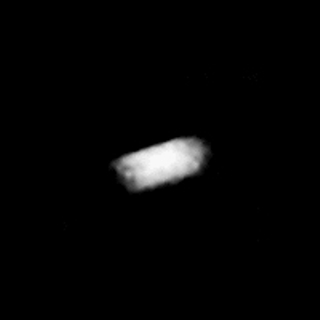Galatea (moon)

Galatea as seen by Voyager 2 (elongation is due to smearing)
|
|
| Discovery | |
|---|---|
| Discovered by | Stephen P. Synnott and Voyager Imaging Team |
| Discovery date | July 1989 |
| Orbital characteristics | |
| Epoch 18 August 1989 | |
| 61 953 ± 1 km | |
| Eccentricity | 0.00004 ± 0.00009 |
| 0.42874431 ± 0.00000001 d | |
| Inclination |
|
| Satellite of | Neptune |
| Physical characteristics | |
| Dimensions | 204×184×144 km (±~10 km) |
|
Mean radius
|
88 ± 4 km |
| Volume | ~2.8×106km³ |
| Mass | 2.12 ± 0.08 ×1018 kg |
|
Mean density
|
~0.75 g/cm³ (estimate) |
| ~0.018 m/s2 | |
| ~0.056 km/s | |
| synchronous | |
| zero | |
| Albedo | 0.08 |
| Temperature | ~51 K mean (estimate) |
| 21.9 | |
Galatea (/ˈɡæləˈtiːə/ GAL-ə-TEE-ə; Greek: Γαλάτεια), also known as Neptune VI, is the fourth closest inner satellite of Neptune. It is named after Galatea, one of the Nereids of Greek legend, with whom the Cyclops Polyphemus was in love.
Galatea was discovered in late July 1989 from the images taken by the Voyager 2 probe. It was given the temporary designation S/1989 N 4 The discovery was announced (IAUC 4824) on August 2, 1989, but the text only talks of "10 frames taken over 5 days", giving a discovery date of sometime before July 28. The name was given on 16 September 1991.
It is irregularly shaped and shows no sign of any geological modification. It is likely that it is a rubble pile re-accreted from fragments of Neptune's original satellites, which were smashed up by perturbations from Triton soon after that moon's capture into a very eccentric initial orbit.
Galatea's orbit lies below Neptune's synchronous orbit radius, so it is slowly spiralling inward due to tidal deceleration and may eventually impact Neptune's atmosphere, or break up into a planetary ring upon passing its Roche limit due to tidal stretching.
...
Wikipedia
